![]()
![]()
![]()
Use LEFT and RIGHT arrow keys to navigate between flashcards;
Use UP and DOWN arrow keys to flip the card;
H to show hint;
A reads text to speech;
89 Cards in this Set
- Front
- Back
|
Basic cell ingredients |
1. Cell membrane 2. Cytoplasm 3. Nucleic Acid (DNA and RNA) 4. Ribosomes |
|
|
Prokaryotes |
- DNA not enclosed in a membrane - 1 closed circular chromosome - no membrane- bound organelles - most bacteria have cell walls containing peptidoglycan - multiply by binary fission |
|
|
Eukaryotes |
- have a nucleus - have a specific number of linear chromosomes - have membrane- bound organelles - cell wall (if present) made of simple polysaccharides - divide by meiosis/mitosis |
|
|
Histones |
The chief protein component of chromatin Packages and orders DNA into structural units |
|
|
What cell's DNA is associated with histones? |
Eukaryotes |
|
|
Peptidoglycan |
A polymer consisting of sugars (repeating disaccharide units) and amino acids (polypeptides) that form a mesh within prokaryotic bacterial walls These cell walls are the only places on earth that peptidoglycan can be found |
|
|
Which prokaryotic bacteria do not contain peptidoglycan? |
Archaeal cell walls lack peptidoglycan, but some have a chemical that is similar |
|
|
Binary fission |
The chromosome of the cell is copied, and the cell splits in two |
|
|
Polysaccharides |
A carbohydrate consisting of sugar molecules bonded together
Ex: cellulose and chitin |
|
|
Glycocalyx |
A "sugar coating" that surrounds bacterial cells |
|
|
Types of glycocalyx |
Capsule Slime layer |
|
|
Capsule |
A glycocalyx that occurs when the surrounding substance is organized and firmly attached to the cell wall |
|
|
Slime layer |
A type of glycocalyx that occurs when the surrounding substance is unorganized and loosely attached to the cell wall |
|
|
Functions of capsules |
- contribute to the virulence of bacteria by preventing phagocytosis by WBC (has no antigen, so no antibody can be made) - Prevents desiccation - Allows bacteria to adhere to various surfaces |
|
|
Bacteria that are only pathogenic with a capsule |
1. Streptococcus pneumoniae 2. Bacillus anthracis |
|
|
Desication |
Drying out |
|
|
How can it be determined if a bacterial cell has a capsule? |
Capsule stain Aka negative stain Staining the background with an acidic dye |
|
|
Cell wall |
Semi-rigid structure outside the cell membrane |
|
|
Functions of the cell wall |
Responsible for the shape of the cell Prevents bacteria from rupturing in hypotonic environments |
|
|
What is the main structural component in bacteria? |
Peptidoglycan |
|
|
NAM |
N-acetylmuramic acid Repeating disaccharide units |
|
|
NAG |
N-acetylglucosamine Repeating disaccharide units |
|
|
Tetrapeptide side chains |
4 amino acids attached to NAM, linked by peptide crossbridges |
|
|
Repeating disaccharide units within peptidoglycan |
N-acetylmuramic acid (NAM) N-acetylglucosamine (NAG) |
|
|
Gram (+) cell walls |
Thick outer layer of peptidoglycan Contains teichoic acid |
|
|
Teichoic acid |
Holds peptidoglycan to the plasma membrane Is antigenic |
|
|
Antigenic |
The body recognizes it as foreign |
|
|
Gram (-) cell wall |
Thin peptidoglycan layer Second outer membrane, which is considered part of the cell wall |
|
|
What does the outer membrane of a Gram (-) cell wall consist of? |
Lipopolysaccharides, lipoproteins, and phospholipids |
|
|
In a Gram (-) cell wall, how are materials brought through the outer membrane into the cell? |
Porin proteins act as passageways |
|
|
Periplasm |
The space between the outer membrane and the plasma membrane |
|
|
What is the most important stain used in bacteriology? |
Gram stain |
|
|
What are Lipopolysaccharides composed of? |
Lipid A O-polysaccharide |
|
|
Lipid A |
Toxic to humans, causes fever |
|
|
O-polysaccaride |
Antigen useful in identifying species of bacteria |
|
|
Gram Stain |
1884: developed by Hans Christian Gram Divides bacteria into 2 groups based on their cell structure |
|
|
Into what groups does the gram stain divide bacteria? |
1. Gram positive (thick layer of peptidoglycan in cell wall): stains purple 2. Gram negative(thin layer of peptidoglycan in cell wall): stains pink |
|
|
Unique characteristics of bacterial cell walls |
- Chemically unlike any structure in animal cells - Target for drugs that attack and kill bacteria without harming body cells |
|
|
Penicillin |
-Works by damaging the pentaglycine cross bridges of peptidoglycan layer - works best against Gram (+) bacteria due to thicker peptidoglycan layer |
|
|
Lysozomes |
Enzymes in your body that attack peptidoglycan Found in tears, sweat, mucus, and saliva |
|
|
Acid fast cell walls |
Bacteria with high levels of mycolic acid, making it resistant to staining and prone to clumping |
|
|
Mycolic acid |
Hydrophobic waxy lipid |
|
|
How to identify acid fast cell walls? |
Acid fast stain |
|
|
Structural components of cell membrane |
1. Phospholipid bilayer 2. Proteins |
|
|
Fluid mosaic model |
Phospholipid bilayer has oil consistency Proteins form the mosaic pattern within the bilayer |
|
|
Functions of cell membrane |
1. Selectively permeable membrane 2. Secretes and contains enzymes for bacterial digestion 3. Energy production (Electron Transport System is located here) 4. Enzymes for photosynthesis are located here |
|
|
Enzymes for bacterial digestion |
1. Amylases 2. Lipases 3. Peptidases |
|
|
Why is the enzyme secretion function vital for bacteria? |
They cannot undergo phagocytosis |
|
|
Amylases |
An enzyme that breaks down starches |
|
|
Lipases |
An enzyme that breaks down fat |
|
|
Peptidases |
An enzyme that breaks down protein |
|
|
Cytoplasm |
Substance of the cell inside the cell membrane 80% water Various organic and inorganic molecules dissolved inside the cytoplasm |
|
|
Nucleoid |
Contains 1 closed circular chromosome Not surrounded by membrane Usually attached to plasma membrane at some point |
|
|
Plasmids |
Small, circular, extrachromosomal pieces of DNA that encode auxiliary metabolic functions "Additions" that can be traded |
|
|
Auxiliary metabolic functions |
Abilities out and above of normal metabolic functions |
|
|
Abilities that plasmid genes can code for: |
Antibiotic and heavy metal resistance Production of toxins Genes that allow for the transfer of the plasmid to other bacteria |
|
|
Ribosomes |
Site of protein synthesis Made up of 2 subunits that are only intact during protein synthesis |
|
|
What are ribosomes made of? |
RNA and proteins |
|
|
Bacterial ribosomes |
Small subunits (SSU) = 30S Large subunits (LSU) = 50S Total size of bacterial ribosomes = 70S |
|
|
Endospores |
- Tough, dormant structures bacteria produced in vegetative cells to survive harsh conditions |
|
|
Vegetative cells |
Metabolically normal/growing cells |
|
|
Sporulation |
Formation of spores Occurs when a key nutrient becomes scarce or unavailable |
|
|
Where is sporulation found? |
Gram (+) bacteria |
|
|
Process of sporulation |
1. Vegetative cell walls creates a copy of its chromosome and surrounds it with a thick protein coat 2. When the cell dies, the spore is released 3. The spore remains dormant until the spore coat is disturbed, at which point it will germinate back to a vegetative cell |
|
|
Characteristics of endospores vs vegetative cells |
Extremely resistant to heat, cold, chemicals, lack of water, etc
Can remain viable for years |
|
|
Anaerobic bacteria |
Bacteria that is normally killed by O2 Uses spores to survive in an oxygen environment |
|
|
Endospore Stain |
Differentially stains spores: Cryptobiotic Vegetative cells |
|
|
Cryptobiotic |
Metabolically inert |
|
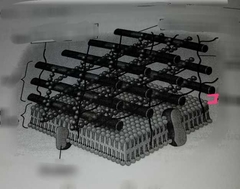
|
Granule layer |
|
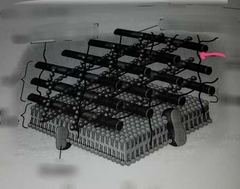
|
Lipoteichoic acid |
|
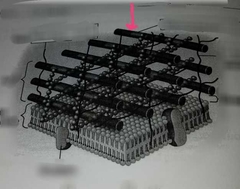
|
Peptidoglycan |
|
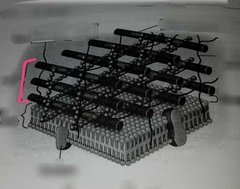
|
Cell wall |
|
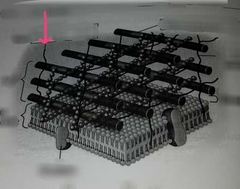
|
Wall teichoic acid |
|

|
Plasma membrane |
|
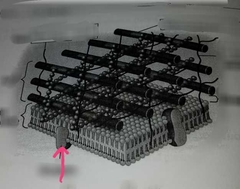
|
Protein |
|
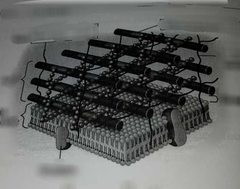
|
Gram Positive |
|
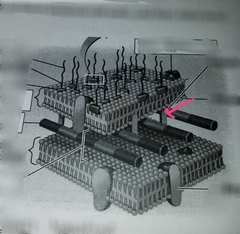
|
Lipid protein |
|
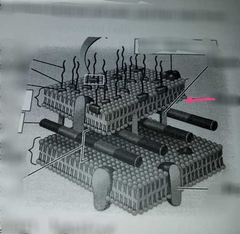
|
Phospholipid |
|
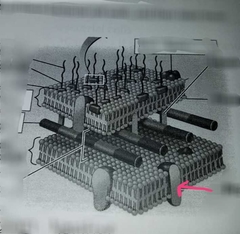
|
Protein |
|
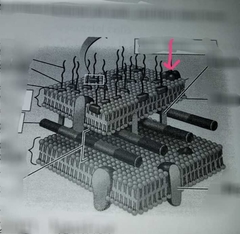
|
Porin protein |
|
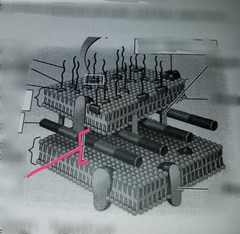
|
Periplasm |
|

|
Plasma membrane |
|
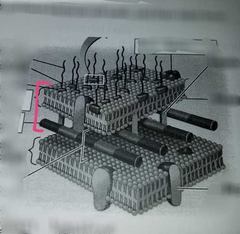
|
Cell wall |
|

|
Peptidoglycan |
|
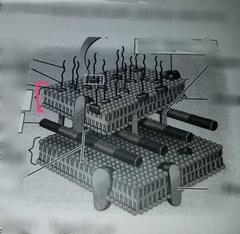
|
Outer membrane |
|

|
Lipopolysaccharide |
|
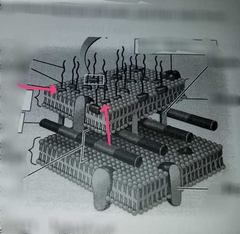
|
Lipid A |
|
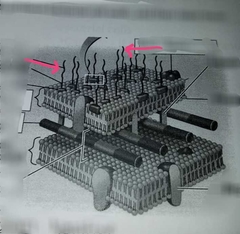
|
O-polysaccharide |
|

|
Gram Negative |

